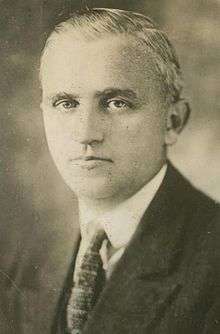Loring M. Black Jr.
Loring Milton Black Jr. (May 17, 1886 – May 21, 1956) was an American politician and a United States Representative from New York.
Loring Milton Black Jr. | |
|---|---|
 | |
| Member of the U.S. House of Representatives from New York's 5th district | |
| In office March 4, 1923 – January 3, 1935 | |
| Preceded by | Ardolph L. Kline |
| Succeeded by | Marcellus H. Evans |
| Member of the New York Senate | |
| In office January 1, 1911 – December 31, 1912 | |
| Preceded by | Reuben L. Gledhill |
| Succeeded by | Henry P. Velte |
| Constituency | 4th district |
| In office January 1, 1919 – December 31, 1920 | |
| Preceded by | Charles F. Murphy |
| Succeeded by | William T. Simpson |
| Constituency | 6th district |
| Personal details | |
| Born | May 17, 1886 New York City |
| Died | May 21, 1956 (aged 70) Washington, D.C. |
| Citizenship | |
| Political party | Democratic |
| Spouse(s) | Beatrice M. Eddy Black |
| Education | Fordham University B.A Columbia Law School |
| Profession | Attorney |
Biography
Loring was born in New York City on May 17, 1886, a son of Loring M. Black and Elizabeth Black.[1] He attended the public schools of New York City and was a 1903 graduate of Fordham Preparatory School.[1] In 1907, he graduated from Fordham University with a Bachelor of Arts degree.[1] He attended Columbia Law School from 1907 to 1909, was admitted to the bar in 1909, and practiced in New York City.[1]
Black was a member of the New York State Senate (4th D.) in 1911 and 1912.[2] Due to his young age he became known as the "Kid Senator".[3] He was again a member of the State Senate in 1919 and 1920.[2]
Black was elected as a Democrat to the 68th, 69th, 70th, 71st, 72nd and 73rd United States Congresses, holding office from March 4, 1923 to January 3, 1935.[2] Opposing prohibition, he was one of the leaders of the "wet bloc" in Congress.[2] Black served as chairman of the Committee on Claims in the 72nd and 73rd Congresses.[2]
After leaving Congress, Black resumed the practice of law in New York City and Washington, D.C.[2] He died of a heart attack on May 21, 1956, while shopping in a Washington, D.C. drugstore.[4] He was buried at Fort Lincoln Cemetery in Brentwood, Maryland.[2]
Family
In 1913, Black married Beatrice Marie Eddy.[5] Their children included Loring M., Elizabeth V., Jeanne, and John E. The Blacks later divorced, and Loring Black's second wife was Laura Spencer.
References
- Murlin, Edgar L. (1912). The New York Red Book. Albany, NY: J. B. Lyon Company. p. 95 – via Google Books.
- U.S. Congress (2005). Biographical Directory of the United States Congress, 1774-2005. Washington, DC: US Government Printing Office. p. 661. ISBN 978-0-1607-3176-1.
- "Riggs Loses, 42 to 2". The New York Times. New York, NY. February 28, 1912. p. 1 – via Newspapers.com.
- "Death Notice, Loring M. Black". Daily News. New York, NY. May 24, 1956. p. 55 – via Newspapers.com.
- "Miss Eddy Weds Mr. Black". Brooklyn Life. Brooklyn, NY. June 14, 1913. p. 15 – via Newspapers.com.
External links
- United States Congress. "Loring M. Black Jr. (id: B000505)". Biographical Directory of the United States Congress.
- Loring M. Black Jr. at Find a Grave
| New York State Senate | ||
|---|---|---|
| Preceded by Reuben L. Gledhill |
New York State Senate 4th District 1911–1912 |
Succeeded by Henry P. Velte |
| Preceded by Charles F. Murphy |
New York State Senate 6th District 1919–1920 |
Succeeded by William T. Simpson |
| U.S. House of Representatives | ||
| Preceded by Ardolph L. Kline |
Member of the U.S. House of Representatives from New York's 5th congressional district 1923–1935 |
Succeeded by Marcellus H. Evans |